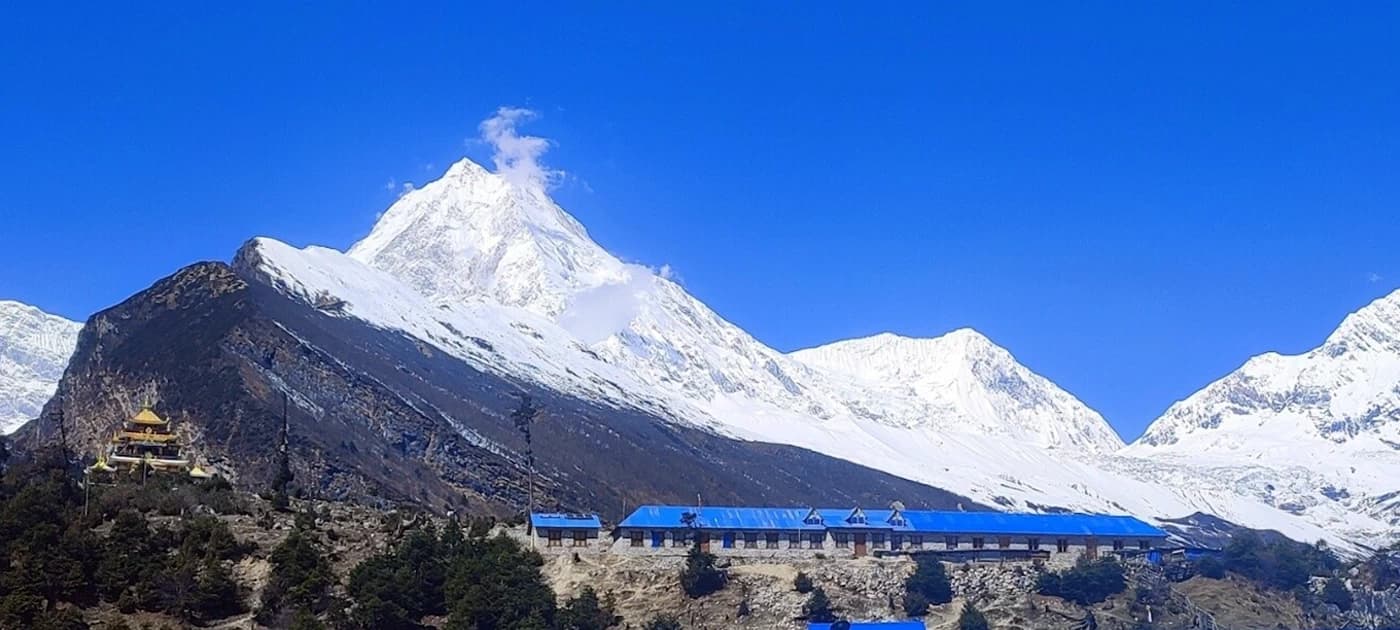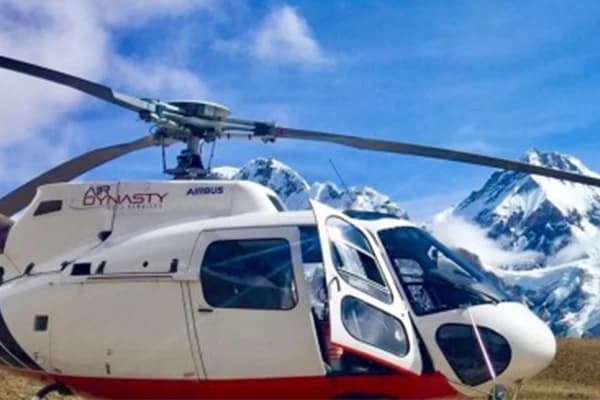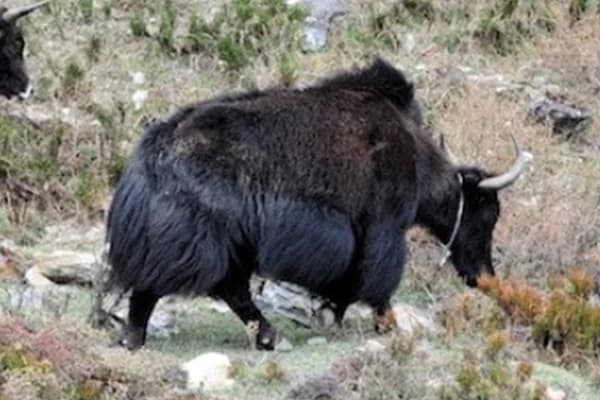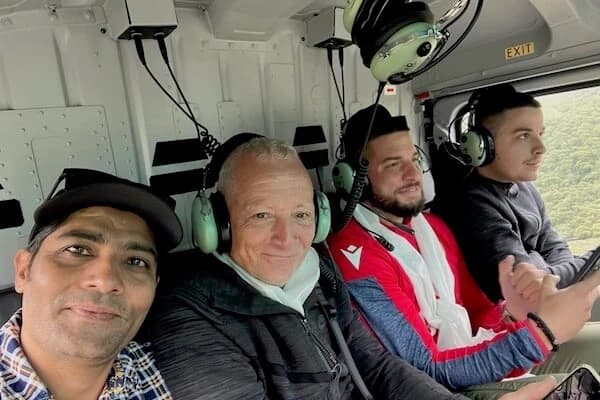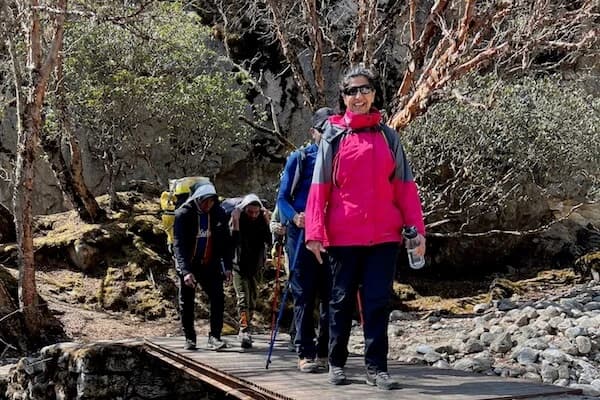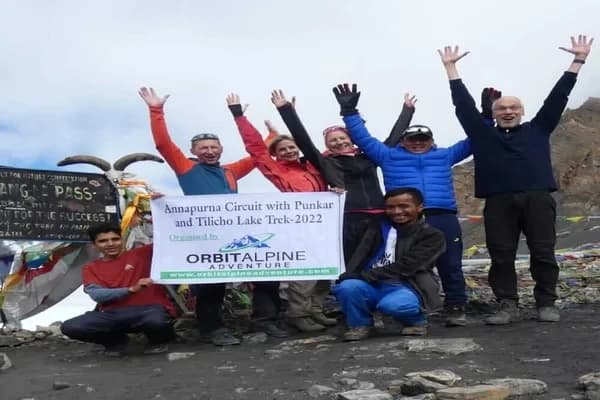Seeking to experience one of the best treks in Nepal? Explore Manaslu Circuit Trek as it puzzles the edge of the Manaslu Conservation Area and leads one to a wonderful view of the eighth-highest mountain in the world.
Ultimate Guide to Manaslu Circuit Trek
The circuit takes you from the steamy lowlands with their rice and millet terraces through the mighty gorges of the Budi Gandaki, with their greenish-blue waters and amazing waterfalls. The suspension bridges on the Manaslu trek are in an association of their own for both length and height.
A great glacial valley bursts into view. An amazing wall created by Cheo Himal, Himlung Himal, Nemjung, Gyaji Kang, and Kang Guru casts down a stream of glaciers while Annapurna II rises ahead. This view alone makes the trek worthwhile. Magical Nepal can arrange your all-inclusive 13-day trek.
Overview of Manaslu Circuit Trek
The Manaslu Circuit Trek is a trek over the High Mountain of Mt. Manaslu, 8,163 meters or 26,781 feet above sea level, and is regarded as the eighth-highest mountain in the world. It cuts across from west to east through some of the least spoiled and culturally rich regions of the Himalayas that lie within the Gorkha District of Nepal. Thus, it was a great combination of exciting routes and scenery along with authentic cultural experiences that always made Manaslu Circuit Trek popular among trekkers who needed alternatives to Everest and Annapurna without commercialization. It is a rather off-the-beaten-track journey; hence, it suits the kind of people who do not want to fall prey to giant crowds of people while soaking in the beauty and calmness of the Himalayas.
Following is a detailed overview of the trek, inclusive of its cultural importance, geography, seasons, and what one is most likely to find along the way.
Cultural Significance and History
Manaslu is a culturally very rich region, lying very close to the Tibetan border and being closely related to Tibetan Buddhism. Equally, it is a trek to various villages that lie isolated from the highly influencing Tibetan culture, language, and religion. The main local communities are from ethnic groups like Gurung and Tibetans, friendly and possessing a very spiritual way of life.
The landscape is dotted with ancient monasteries, prayer wheels, and Mani walls that give trekkers glimpses into centuries-older traditions. Manaslu is a Sanskrit name and means "Mountain of the Spirit"; it is considered a holy mountain by both Hindus and Buddhists. The area has long been established as a trading route between Nepal and Tibet, to which caravans of yaks and mules, transporting goods between the two areas, still testify. For many, this is not a trek of physical challenge alone but a spiritual journey where one gets to interact with the local communities and their way of life.
It was in 1991 that trekking around Manaslu opened up, but this circuit is far less commercialized than other famous routes in Nepal, such as Everest Base Camp or the Annapurna Circuit. Access is restricted need to get special permits and travel with a guide helps retain this region in its remote charm and authenticity.
Geography and Terrain
This makes the whole trek vary from subtropical lowlands around Soti Khola to alpine heights as one approaches Larkya La Pass, which is at a height of 5,160 meters-the highest for the whole trek. Most of the trek follows Budhi Gandaki, through dense forests and steep-sided gorges with terraced fields and villages, finally opening up to barren high-altitude
landscapes typical of the Himalayas.
However, this scenario changes quite drastically as one goes upwards. The lower reaches of this particular region are thick with greenery-mostly rhododendrons, bamboo, and pine forests, with terraced farmlands wherein the local inhabitants grow millet and barley among others. At this heightened altitude, the forests break into alpine meadows, glaciers, and towering snow-capped peaks with Mt. Manaslu itself looms large in the backdrop.
It all builds up to the complete long day across the Larkya La Pass for some wonderful views on this trek. Great panorama view of the Himalayan peaks viewed from the summit of this pass include Himlung Himal at 7,126m, Cheo Himal at 6,820 meters, and Annapurna II at 7,937 meters. You'll get to enjoy more view if you try Manaslu Tsum Vakkey trek.The route from here descends through the attractive village of Bimthang, where green grasslands meet the trekker to reach the unspoiled rivers while making his way down to lower altitudes.
Manaslu Conservation Area and Wildlife
This trek cuts through the Manaslu Conservation Area, established in 1998 to preserve this part of the Himalayas for its exclusive biodiversity and culture. It measures 1,663 sq km and contains a wide range of flora and fauna, including some enormously rare species. Animals one may spot while trekking include the Himalayan tahr, snow leopard, red panda, and blue sheep. The region is home to immense birdlife, with over 110 species recorded within the area.
It represents not only a haven for wildlife but also a model of sustainable tourism. Efforts are made so that tourism benefits the local communities, keeping the environmental impact on the region as low as possible. Similarly, trekkers are encouraged not to litter or waste but instead to make use of eco-friendly teahouses that support conservation efforts.
Seasons: Best Time to Trek
Spring and autumn are the best times to trek in the Manaslu Circuit. During these two seasons, one can be a witness to the most favorable weather conditions, crystal clear sky, and spectacular mountain peaks.
- Spring (March to May): It is the best time for trekking because rhododendron forests have turned into a completely blooming time. The higher the altitude, the higher the temperature will be obtained gradually. While the temperatures at relatively lower altitudes are very mild, higher regions can get cold, particularly at night. The skies are normally clear and the snow-peak views are the best.
- Autumn: According to the best things, this period starting from September to November is the best time of the year to go trekking because right after the monsoon there are clear skies and steady weather conditions. The sceneries will be luxurious green from summer rains and at perfect temperature during the day for trekking. Higher altitudes will be cold, though, particularly when you reach the Larkya La Pass.
- Winter (December to February): One can go trekking during the winter also, but that too is not recommended to many because of heavy snow at Larkya La Pass, and the trekking gets too challenging. Sometimes temperatures can fall below freezing, especially at higher altitudes, while many tea houses are shut during this period.
- Monsoon (June to August): This period of the year sees heavy rainfalls; thus, one should expect landslides in lower parts. The trails will be muddy and slippery. Clouds often unclear mountain views, therefore these months are not considered a perfect period of trekking.
The general duration for the Manaslu Circuit Trek takes between 13 days to 18 days, all dependent on the route taken and speed at which one treks, including acclimatization. Because of its high elevations and changing topography, the Manaslu Circuit is rated as a moderately difficult trek. Trekkers should be in good physical shape, as the path includes long day treks often between 5 to 7 hours; some parts will require them to go up and down on steep, rocky trails.
Acclimatization becomes important and is not to be trifled with, as altitude sickness can easily become fatal, at a crossing of 5,160 meters at Larkya La Pass. The community characteristics are such that the program has days allocated for acclimatization especially in Samagaun at 3,530 meters and Samdo at 3,875 meters, which can offer opportunities for side hikes to either Manaslu Base Camp or the Tibetan border.
Although the trek is pretty challenging, it's achievable for experienced trekkers and also beginners who are physically fit and prepared for the long tiring days of trekking at high altitudes. A guide is compulsorily necessary for this trek; porters can be arranged who will carry heavy loads so trekkers can enjoy the beauty around them.
Unique Aspects of Manaslu Circuit
Possibly, the most prominent thing about the Manaslu Circuit Trek is just how remote it feels. While the paths to Everest and Annapurna are crowded with tourists, this, in comparison, remains a relatively quiet chance to experience the Himalayas in relative solitude. This remoteness does translate to fewer teahouses and conveniences along the trail, so trekkers should be prepared for basic accommodations and simpler meals compared to more developed trekking regions.
The trek offers an educational experience in the cultural terms, too. Villages along the route are less touristy hence allowing for good interaction with people. A trekker gets the chance to witness traditional Tibetan Buddhist practices, visit some of the ancient monasteries, and explore a way of life that has remained unchanged for centuries.
Finally, there is the selectness that arises from the status of a restricted area: it takes special permits to go trekking here, and must be accompanied by a guide to protect this exceptional cultural and natural heritage. This also means that the trail is less commercial, offering a purer, more immersive trekking experience.
This Trek covers rich culture, overwhelming landscapes, and bodily challenges, making it supreme among trekking enthusiasts who wish to pursue a less-trained Himalayan experience. From the high peak down to peaceful villages, and even into spiritual atmosphere-like conditions, the Manaslu Circuit promises memorable memories to any trekker.
Manaslu Circuit Trek Detailed Itinerary
The Manaslu Circuit Trek normally takes from 14 to 18 days depending on your pace and acclimatization schedule. Given below is the typical 15-day itinerary of the Manaslu Circuit Trek:
Day 1: Drive to Soti Khola [700m]
7-9 hours driving on Starting day of our trek to Soti Khola via a scenic drive through rural Nepal with rivers, villages, and terraced fields.
Day 2: Trek to Machha Khola [869m]
Duration: 6-7 hrs of trekking,
It follows the Budhi Gandaki to its origin, passing through forests and small villages.
Day 3: Machha Khola to Jagat
Duration: 6-7 hours
It crosses several suspension bridges, passes by several hot springs en route, and concludes at the entry point into the Manaslu Conservation Area.
Day 4: Jagat to Deng
Duration: 6-7 hours
The trek continues on an uphill climb but most of the time passes Buddhist villages and enjoys super views of the mountain.
Day 5: Deng to Namrung
Duration: 6-7 hours
Enter the Nubri Valley where the Tibetan culture is more profound and get the views of Manaslu and other peaks.
Day 6: Namrung to Lho (3,180m)
Duration: 5-6 hours
Lho: A nice village, it offers a great view of Manaslu and its culture can be experienced from the local monastery.
Day 7: Lho to Samagaun (3,530)
Duration: 4-5 hrs
Day relatively easy day trekking to great views of Manaslu. Samagaon is a slightly bigger village, and you can visit the famous Pungyen Gompa here.
Day 8: Extra day for acclimatization in Samagaun
Explore Birendra Lake or hike up to Manaslu Base Camp for acclimatization.
Day 9: Samagaun to Samdo (3,875m)
Duration: 3-4 hours
Short trek in high-altitude landscapes amidst Tibetan peaks.
Day 10: Samdo-Dharamsala / Larkya Phedi (4,460m)
Duration: 3-4 hours
The route brings you closer to the Larkya La Pass and closer to glacial moraines.
Day 11: Cross Larkya La Pass (5,160m) and Trek to Bimthang (3,590m)
Duration: 7-9 hours
Difficult day of the trek as you cross high-altitude Larkya
La Pass with a magnificent view of peaks like Himlung Himal and Cheo Himal.
Day 12: Bimthang to Tilije (2,300m)
Duration: 5-6 hours
A day starting with a descent through forests of rhododendrons, pastures, and a slow goodbye to the high mountains.
Day 13: Tilije to Tal (1,700m)
Duration: 5-6 hours
Merge into the Annapurna Circuit route. Today is a mix of descent and flat.
Day 14: Tal to Syange (1,080m)
Duration: 5-6 hours
Continue the descent into the Marsyangdi Valley.
Day 15: Drive from Syange to Kathmandu
Duration: 7-8 hours
A scenic drive back to Kathmandu concludes the end of the trek.
Things to Know About Manaslu Circuit Trek
Permits and Regulations
Manaslu Circuit falling under the category of restricted areas calls for a couple of permits to cover this journey.
Manaslu Restricted
Area Permit: This is mandatory, and it requires different costs according to the season during peak seasons. From September to November costs are higher, nearly USD 100 for one week, while every additional day is charged at USD 10. During the off-season-from December to August, charge is about USD 75 for the first week.
MCAP
Manaslu Conservation Area Permit: This permit is allocated only for trekking in the Manaslu Conservation Area and also costs about 30 USD per head.
ACAP - Annapurna
Conservation Area Permit: The last part of the trek touches the Annapurna region; hence, this permit also comes into force and also costs approximately 30 USD. The same consideration also exists for the trekkers, where it prescribes that this trek has to be done with a registered guide and at least in a group of two or more persons.
Packing List
Clothing:
-
Base layers: moisture-wicking thermal top and thermal bottom
- Insulating mid-layers: Fleece or wool jacket.
- Waterproof and windproof jacket and pants for outer layering.
- Trekking pants/shorts: to be made of lightweight, quick-drying material.
- Down jacket: this will be necessary in case of cold nights that may have to be spent at altitude.
- Trekking boots: Waterproof and with ankle support.
- Socks: wool or synthetic, 3-4 pairs
- Gloves: insulated, with lightweight liners.
- Buff or scarf: for wind and dust protection.
- Hats: Woolen for cold nights and wide-brimmed for sun protection during the day.
Equipment:
- Daypack: 35-45 liters
- Sleeping Bag: rated for -10°C, or lower
- Trekking poles: These will be used on uneven grounds for balance.
- Headlamp: Along with extra batteries
- Water bottles: 2-3 liters capacity
- Water Purification: Tablets or filters
- Sunglasses: UV protection.
Others:
- First Aid Kit: Including altitude sickness medication.
- Snacks: Energy bars, nuts.
- Toiletries: Biodegradable soap, hand sanitizer, and tissues.
- Permits and documents: Passports, trekking permits, and cash (in small towns where no ATMs are available).
- Smart packing will offer comfort and safety on the trek while
- keeping loads manageable.
Physical Preparation
Fitness level required
The Manaslu Circuit Trek involves higher distances on rough terrain above 5000 meters above sea level. A trekker has to cover a distance of 12-20 km every day. It is a fitness-demanding adventure, and prior preparation with good health conditions is required so that it might be safely done and enjoyed to the fullest moments. Cardiovascular
Fitness The most important part of your training is going to be cardiovascular fitness. Every day of trekking involves 5-7 hours of going up and down, which alone takes a lot of cardio. So, start off by having one week of 3-4 days of starting to hike, run, swim, cycle, or do any cardio workout. The training for this should be started at least 2-3 months in advance but would be ideal if you kept it going right till two weeks before your departure.
Gradually increase the duration and difficulty level of the workout. The muscles of the legs must be strong enough to bear the brunt of the trek on such uneven trails. Thus, quadriceps, hamstrings, and calf muscles must be focused on with exercises like squats, lunges, and step-ups. Core stability will also come in handy during those rocky pathways; hence, planks and leg raises may be included in your workout list.
Altitude Acclimatization
Because the Manaslu Circuit reaches altitudes over 5,000 meters, you need to understand something about altitude sickness. Incorporate into your training some high-altitude hikes-if possible your body learns what it feels like to live in a low oxygen environment. Not everyone is going to be able to train at high altitudes. However, it helps in acclimatization to acclimate breathing techniques and keeping your body hydrated.
Flexibility and Recovery
Flexibility training through practices like yoga or stretching exercises will greatly help in improving mobility and reducing the risk of injury. On the other hand, rest and recovery are equally important; adequate sleep allows your muscles time to recover after hard training sessions. With your body fully prepared, you will have increased your chances of safely completing the trek and fully enjoying the beauty of the Manaslu Circuit.
Accommodation and Food:
Teahouses on the Manaslu Circuit have basic lodging facilities, usually sharing a basis and common bathrooms. Meals are normally simple but sufficient in calorie intake, hence would normally consist of dal bhat, which is rice and lentils, and Tibetan bread.
Cost of Trek
A breakdown of the budget for the Manaslu Circuit Trek can be given below, roughly:
Permits: $100-150 USD
Guide and Porter: Guides are paid approximately around USD
25-30 per day, while for a porter, it's around USD 15-20 per day.
Accommodation: Teahouses, $5 to $10 per night in USD, Meals:
$ 5 to 8 approximately for one meal
Safety and Health Tips
Acclimatization: This altitude sickness factor due to more than 5,000 meters of elevation is considered the major concern in the Manaslu Circuit. Go upwards gradually, taking rest time in places like Samagaun to let your body get acclimatized with the altitude. Watch for signs and symptoms of AMS-headache, vertigo, and nausea, which might set in time without notice. If the symptoms persist and further deteriorate, then immediate descent is to be sought to avoid serious complications like HAPE or HACE. If you are don't want to reach that high and want to return from the bottom, you can choose the Manaslu short trek option which will save your time as well and don't have to suffer from altitute sickness.
Hydrate: Drinking at least 3-4 liters of water per day will avoid any cases of dehydration that may heighten the possibility of altitude sickness. Bring with you water purification tablets or filters for safe drinking water.
Proper Nutrition: High-energy foods, more carbohydrate-oriented, are a must since there are long days of trekking. Energy bars, nuts, or dried fruits are good for quick snacks.
First Aid Kit: Medications for altitude sickness include Diamox, pain relievers, bandages, antiseptic, and blister care products. Also, pack personal medications.
Dress in Layers: The weather is highly unpredictable, and you should be ready with moisture-wicking, active wear base layers, insulating mid-layers, and waterproof outerwear. Make sure to have enough warm clothes at night and proper rain gear.
Guided Trek: Manaslu Circuit Trek requires compulsorily licensed guidance. Apart from navigation, the guide needs to create an environment that is safe for trekkers in emergencies, which may not have immediate options for rescue.
Conclusion
The Manaslu Circuit Trek combines natural beauty, cultural richness, and physical challenge all in one, forming a truly unique experience right in the heart of the Himalayas. Being one of the less commercialized trekking routes in Nepal, it offers just that chance for those in search of solitude and unspoiled scenery. This trek ranges from subtropical forests with terraced fields to alpine heights with snow-capped peaks at higher elevations along this path. The variety and magnificence of the Himalayas around are shown along the full length of this trek.
Besides the beautiful landscape, Manaslu Circuit offers views of some of the most beautiful peaks over 7,000 meters, a chance for acquainted with the local Tibetan Buddhist communities through visits to some of the century-old monasteries, and learn about their way of livelihood. Trekkers will also feel a sense of achievement as the trek offers them a view of crossing one of the tough passes, Larkya La Pass.
It's a challenging trek, but the route has been reasonably accessible to fit trekkers and appropriately acclimatized individuals in the past, and thus as a superb enterprise for experienced trekkers and determined novices alike.
Frequently Asked Questions
What is a restricted area permit? And why is it needed for trekkers to do trekking in Nepali restricted area trekking routes?
1. When should I trek the Manaslu Circuit?
The best times for the Manaslu Circuit Trekking are in spring-March to May- and autumn-September to November. These periods have relatively stable weather conditions with clear skies and temperate temperatures, hence providing ideal conditions for trekking.
2. Do I need a permit to trek the Manaslu Circuit?
Yes, you need a Restricted Area Permit, a Manaslu Conservation Area Permit, and an Annapurna Conservation Area Permit. These permits are basically required for entry into the region and can be obtained through a licensed trekking agency.
3. Is independent trekking allowed in the Manaslu Circuit?
No, for protection and preservative reasons of this rare environment and culture, one really has to go for the Manaslu Circuit trek with a licensed guide and obtain the permits.
4. How difficult is the Manaslu Circuit Trek?
This high-altitude trek involves different kinds of terrain and has been graded as moderate and difficult. The climb to Larkya La Pass is exhausting up to 5,160 meters, which necessitates a decent level of physical fitness with good acclimatization.
5. How long does it take to trek?
Usually, the Manaslu Circuit Trek takes anything from 14 to 18 days according to your speed and acclimatization. This includes rest days and proper acclimatization at higher altitudes.
6. What can I expect about the accommodation?
Manaslu Circuit accommodations are teahouses, shared rooms, shared bathrooms, and very basic amenities. Accommodation is simple, yet it suffices to satisfy the needs of trekkers.
7. What should I bring along for the trek?
Key items to bring will include warm clothes, a rain jacket, hiking boots, below below-zero-rated sleeping bag, a first aid kit, and enough water supply. Please see the detailed pack list for specifics.
8. Do I have a mobile phone signal on the trek?
There is some mobile coverage in the lower parts of the areas, but the higher and further from civilization, it will be bad or more often, simply just not there. It is worth considering purchasing a satellite phone or renting a local SIM card for emergency purposes.
9. What is the altitude risk, and how can I prevent altitude sickness?
Due to the high altitude, altitude sickness is also one of the risks around the Manaslu
Circuit. Proper acclimatization prevents altitude sickness by taking rest days hydrating and slowly ascending. Watch for symptoms and descend if severe.
10. Are there any dietary restrictions or special food requirements?
Although teahouses offer simple meals, including Nepali and Tibetan cuisine, the variety of the selection of the food items may be limited. If you have any particular diet requirements, it is better to tell your trek agency in Kathmandu. You are also suggested to take energy-rich snacks or any specific food with you.
